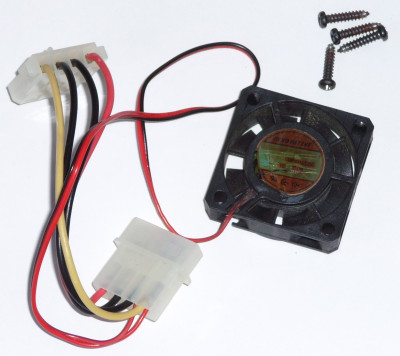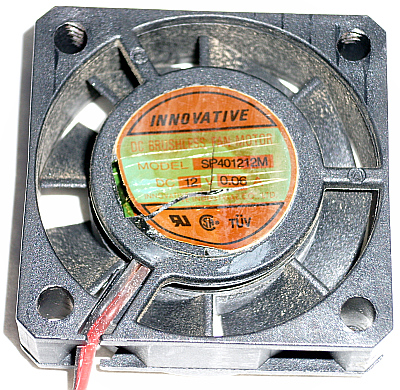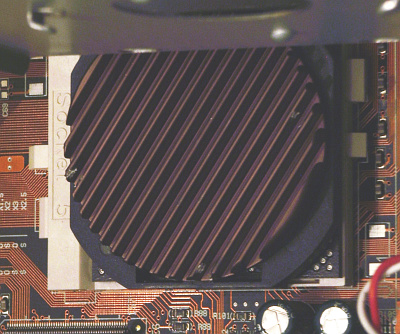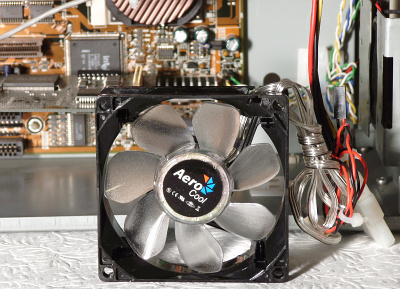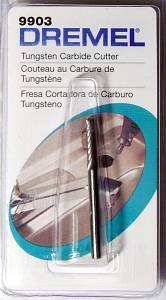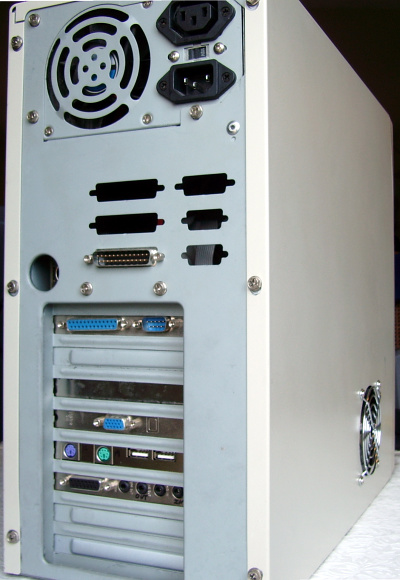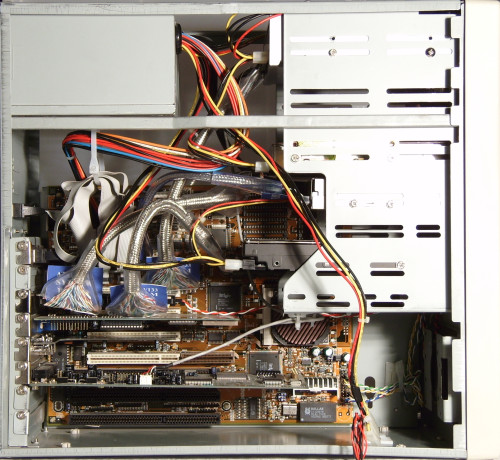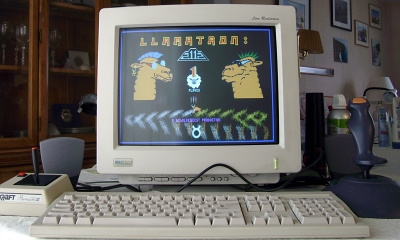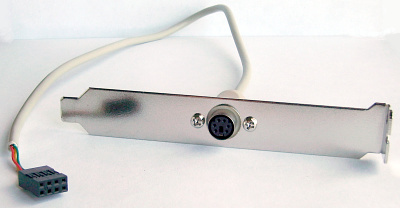Baby AT Pentium
Last modified: 2023-08-05 20:01
Overview
Some years ago I was stupid enough to pay a short-lived computer store to
build a PC for me. It was never particularly stable, and when the
2 GB hard drive failed catastrophically I gave up on it. I put a new
17 GB hard drive in it, tried unsuccessfully to sell it, and finally left
it for years in non-climate-controlled storage. But after my other
spare computers all got jobs, I
resurrected the Pentium to have an extra computer to tinker with.
A
new PS2/USB
combo card, an old CD burner and a second, 20 GB hard drive from the
spare parts drawer went a long way toward making it usable again, but there
were some glitches to deal with:
Once the system was stable, I succeeded in installing Windows 98 SE,
FreeDOS,
and Slackware Linux in
a triple boot configuration, with Linux running off of
a RAID-0 root file system. However,
it soon became clear that the best use for this old PC was
running classic DOS video games. A bit more
tinkering was needed to make a new optical USB trak ball visible from
DOS.
Vital statistics

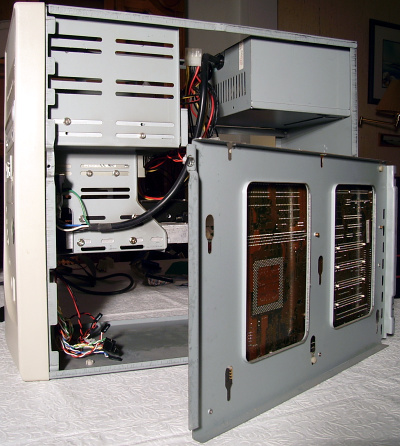
| Vintage | Probably Q3-Q4 1996 |
| Form factor | Baby AT |
| CPU | 166 MHz Pentium, sSpec SL24R? (a) |
| CPU socket | Socket 5? (b) |
| CPU maximum power dissipation | 14.5 W |
| Motherboard | ASUS P/I-P55TP4XE, rev. 2.1? (c) |
| Chipset | Intel 430FX |
| Last BIOS version | 1998-11-25 (0302) |
| RAM | 96 MiB (2 × 16 MiB + 2 × 32 MiB) |
| L2 cache | 256 KiB SRAM module |
Question marks
(a) SL24R is the only plausible sSpec number that came up in
Intel's Processor Finder (no longer available), but I can't confirm it. The
only markings on the top of the processor are "Intel Pentium i166." These
top markings (or lack thereof) match those documented by Intel for "cC0-Step
Production PPGA Units." The Pentium Processor Specification Update (January
1999) lists no fewer than 11 sSpec numbers with the same combination of
processor speed, bus speed, and stepping.
(b) On the motherboard, the socket is quite clearly marked
"Socket 5." However, the motherboard manual came with a technical update
saying that it was newly upgraded to Socket 7. Socket 7 is
backward-compatible to Socket 5 CPUs, so the "Socket 5" indicia might be an
anachronism. The
cited Wikipedia
article claims "All desktop Pentiums from P54CS onwards used Socket 7."
For SL24R, Intel's Processor Finder said "Package Type: Socket 5/7."
(c) The motherboard came with documentation discussing
revs 2.1 and 2.4. The jumper configuration agrees with rev. 2.1 as
amended by a technical update that ostensibly applied only to rev. 2.4, but
which altered portions of the documentation that applied only to
rev. 2.1. Unclear what happened to revs 2.2 and 2.3.
Pathological case
The case design really sucks. You have to take the motherboard out
just to install a hard drive. This seems to be the way it is with Baby AT
cases unless you have a short mobo that doesn't go all the way across.
Unfortunately, this one does. Some new cases claim to be Baby AT
compatible but I don't see how they could really work.
CPU throttling
You wouldn't think a mere 14.5 W would be enough to overheat anything,
but sure enough, the darned thing went from slow to super extra slow after the
CPU was loaded for a while. Or so it seemed. I have no proof since
neither the temperature nor the throttling state were accessible from
software. However, I am pretty sure that Pentiums of this vintage do
support thermal throttling, and it certainly did get hot.
Issue #1: no air. Those tiny slits at the bottom of the front
panel were the only intake vents, unless you count the keyboard port, and they
didn't work too well blocked by carpet and dust. For lack of a better
plan, the air found a way in through the 5¼″ floppy drive, which
quickly filled up with dust and failed in 1997 or 1998. When that
happened I drilled air holes in one of the bay blanks, which saved the floppy
drive but short-circuited the airflow past the CPU. I should have drilled
bigger holes near the bottom of the front panel instead.
Issue #2: dead CPU fan. This 4 cm fan was attached to the heat
sink by driving screws between the fins haphazardly. It was completely
frozen up.
Detail on the dead fan. Definitely not from an Intel retail box
package. There were no indicia on the heat sink.
Despite the intrusive overhang of the hard drive cage, the heat sink easily
unscrewed from the surrounding socket to reveal the top of the processor,
untainted by thermal interface material. I put a dab of left-over Arctic
Silver on it and screwed the heat sink back on as tightly as I dared.
With this design you could easily break the CPU or the socket just by
overtightening the heat sink.
Subsequently I discovered that the heat sink got really hot to the touch
even when the CPU was just idling. According to Intel, the "typical"
power dissipation is only 5.4 W (versus the maximum of 14.5 W). All that
heat from only 5.4 W? Yeeeesh! So much for that silent fanless PC
idea.
Rather than simply replace the 4 cm fan, I decided to cut a hole in the case
and install a powerful 8 cm, 52.8 CFM case fan (AeroCool
X-Blaster) where it would blow outside air directly onto the CPU heat sink,
simultaneously cooling the CPU and fixing the overall ventilation
problem. This fan is a beast, running at 4000 RPM instead of the
2000–2700 RPM that is typical for its size. If you want even
more overkill, there is one more powerful (Vantec
Tornado), but its thickness is 38 mm instead of the
normal 25 mm.
There are competing theories on what is the best way to cut
a hole in a steel computer case.
- Tin snips, nibblers, or other scissors-type tool. Supposedly
quick and easy, but can deform the case.
- Hole saw. Makes a neat hole if you do it right, but it's an expensive
one-trick pony. Besides a hole saw of the correct size you need a serious
drill, a mandrel, and good technique. The difficulty increases with the
size of the hole.
- Dremel. Lots of people do it using cut-off disks even though they
are slow and wear out before you can finish one hole. Not sure why nobody
uses the tungsten carbide cutting bit, or whether it works.
- Jigsaw. Good for big square holes, bad for small round ones.
Hmmm...
It was tempting to try the tungsten carbide cutter, but I knew it was beyond
my abilities to make an even cut freehand, so I went with a 3″ (76.2 mm)
bi-metal hole saw and the people's choice of cutting oil. Of course,
WD-40 may be the people's choice because people are stupid and they do
stupid things like saturate a possible ignition source with a flammable
liquid. So don't try this at home. My years of stupidity keep me in
such constant peril that death by WD-40 doesn't even make the top 100 list of
hazards.
They say that lard is better than WD-40 for steel cutting, but I don't want
rancid pork fat smell blowing out of my PC.
There were a number of false starts until I got the hole saw really level
against the work surface, but once it was properly engaged I gunned the drill
and it was all over in a few seconds amid a cloud of vaporized WD-40.
The four screw holes took much longer—I think my 7/32″ bit is
shot. Afterward, I used the Dremel to grind down the
humongous burrs that the drilling created.
The fan hole ended up slightly off-center. The tiniest sliver of light
shows on the wrong side of the duct in one spot. Although I did mark the
center by estimating from the fan grille instead of measuring meticulously, I
think the primary cause of the misalignment was walking of the hole saw pilot
bit. I should have drilled an even smaller pilot hole for the pilot
bit. I had to do this for the screw holes to keep my dull 7/32″ bit from
walking.
I knew the fan was strong from open-case testing, but only after it was
fully installed did the extent of CFM overkill become apparent. The case
was not designed to be a pressure vessel, but it functioned as one. I
knocked out all of the unused serial port blanks, releasing a steady breeze out
the back, yet there was still enough pressure to force a noticeable stream of
air out the front vents, the drillium panel, the keyboard port, and even the
cracks around the CD burner.
Eventually I swapped the X-Blaster for a more normal 2700 RPM,
37.87 CFM fan (MASSCOOL
FDC08025S1M) to reduce the noise level. There is still plenty of
air coming out everywhere, but it is much quieter. It would be quieter
yet if the fan were balanced, but for $2.99 it's hard to complain.
(Hmmm, now they are only $2.49.)
Hard drive errors
Jan 21 14:58:22 darkstar kernel: hda: dma_timer_expiry: dma status == 0x20
Jan 21 14:58:22 darkstar kernel: hda: DMA timeout retry
Jan 21 14:58:22 darkstar kernel: hda: timeout waiting for DMA
Jan 21 14:58:22 darkstar kernel: hda: status timeout: status=0xd0 { Busy }
Jan 21 14:58:22 darkstar kernel: ide: failed opcode was: unknown
Jan 21 14:58:22 darkstar kernel: hda: drive not ready for command
Jan 21 14:58:22 darkstar kernel: ide0: reset: success
The first thing to try was a different cable. But when I went to replace
the cable, I found that the IDE headers had all 40
pins. Pin
20 is supposed to be a key, and all of my "good" cables had it blocked
out. So I got to do my first pinectomy. (In this photo, the top header is
"before" and the bottom header is "after." This operation soon became old
hat for me as all PCs that predate UDMA/66 have the same issue.)
Then I remembered that I had an extra Promise Ultra66 controller with
nothing better to do (see Curse of the Large PATA
Drive), so I went for broke and gave every PATA device a shiny new 10″
cable and an IDE channel all to itself. I also moved one of the hard
drives up into a 5¼″ bay to improve ventilation. The case left
no air gap whatsoever between drives installed in the lower drive cage,
tempting the wrath of the hard drive gods. (Discus, Chapter 1:
"Thou shalt not cover this hole, lest ye die." Presumably there are
different gods for Western Digital versus Seagate... but I digress.)
After that, the IDE errors went away for a while, but came back when I
replaced the CD burner with a DVD-ROM drive. The optical drive was the
only thing still connected to an IDE header on the motherboard. Switching
it to the other header made the problem go away, so I concluded that the
primary IDE header is flaky.
In addition to the two IDE headers on the motherboard and the two on the
Ultra66 card, there is a single IDE header on the ISA SoundBlaster card for use
with an ATAPI CD-ROM. It is only accessible via ISA PnP. While not
useful in this case, I made use of such an interface later, when I rebuilt a 486.
Non-repeating failures
Fluke #1
The first time I powered up the PC after installing the new fan, the boot
process went off the trolley while I was fully distracted checking out the
airflow. Before I got around to reading the screen, Linux took matters
into its own hands and rebooted. On the second boot, the problem did not
repeat, and it has not repeated since.
The only thing I saw before it all scrolled away was a failure report saying
that it did not find a file system where it expected to. Based on this,
my guess is that the flaky primary IDE interface flaked out, preventing the
hard drive containing the root file system from initializing.
Fluke #2
While I was zeroing out the hard drives in parallel one day, running off of
the Slackware install CD, I got two errors of the form Bad page state in
process '...'. These appeared on the screen when I turned the
monitor on after having hit the Ctrl key twice thinking that the screen blanker
had kicked in. Subsequently the PC went several passes in Memtest86 3.4a
with no failures, so I'm inclined to blame the errors on a kernel fluke that
was triggered by the weirdness of the install CD's runtime environment rather
than a memory fault.
OS installation
I settled on a triple boot configuration of Windows 98 SE, FreeDOS and
Linux, with most of the hard drive space going towards a RAID-0 root file system for Linux. Getting
all that to work at the same time required a surprisingly complicated
lilo.conf.
I wiped out the original partition tables and disklabels without bothering
to note any vital statistics. When I recreated them with fdisk (and failed
to use the -c=dos compatibility option), the geometry changed and I ended up
with the infamous "inconsistent
partition table" error coming from both LILO and the FreeDOS kernel.
FreeDOS has LBA support and still boots and runs OK from cylinder 5035, but
Windows 98 SE does not read the FAT16 file system correctly.
The partition tables and lilo.conf are included below.
Disk /dev/hde: 20.5 GB, 20525137920 bytes
16 heads, 63 sectors/track, 39770 cylinders
Units = cylinders of 1008 * 512 = 516096 bytes
Device Boot Start End Blocks Id System
/dev/hde1 * 1 5034 2537104+ c W95 FAT32 (LBA)
/dev/hde2 5035 6025 499464 1e Hidden W95 FAT16 (LBA)
/dev/hde3 6026 6035 5040 83 Linux
/dev/hde4 6036 39770 17002440 5 Extended
/dev/hde5 6036 6229 97744+ 82 Linux swap
/dev/hde6 6230 39770 16904632+ fd Linux raid autodetect
Disk /dev/hdg: 17.4 GB, 17410498560 bytes
16 heads, 63 sectors/track, 33735 cylinders
Units = cylinders of 1008 * 512 = 516096 bytes
Device Boot Start End Blocks Id System
/dev/hdg1 1 194 97744+ 82 Linux swap
/dev/hdg2 195 33735 16904664 fd Linux raid autodetect
# lilo.conf for Quake 2008-02-18
# Neither fdisk nor cfdisk would create a partition table that did not result
# in the "Inconsistent partition table" error from LILO; nor did lilo -P fix
# actually fix it.
ignore-table
boot=/dev/hde # LILO goes in the MBR.
compact # Boot fast,
vga=normal # and skip the foo-foo.
prompt # Prompt with no timeout.
lba32 # Silence warning about assuming LBA32.
# Definitions for partition hiding.
change-rules
reset
type=FAT16
normal=0x0e
hidden=0x1e
type=FAT32
normal=0x0c
hidden=0x1c
# /dev/hde3 is mounted as /boot, so /boot/vmlinuz is on the non-RAIDed
# partition /dev/hde3.
image=/boot/vmlinuz
# The kernel will automatically assemble the partitions of type 0xfd
# into a RAID array on /dev/md0. Use that as the root file system.
append="root=/dev/md0"
label=linux
read-only
# Need to hide Win98 partition from FreeDOS, which has the classic
# DOS/Windows fault of assuming that it owns C:.
other=/dev/hde2
label=FreeDOS
change
partition=/dev/hde1
set=FAT32_hidden
partition=/dev/hde2
set=FAT16_normal
# Need to hide FreeDOS partition from Win98 because it doesn't read it
# correctly (probably the inconsistent partition table).
other=/dev/hde1
label=Win98SE
change
partition=/dev/hde1
set=FAT32_normal
partition=/dev/hde2
set=FAT16_hidden
¡Cuidado! ¡Hay llamas!
I originally hoped to use the old Pentium PC as a testing ground for new
Linux distributions, but as it happens, the Linux distributions that are
currently the most popular are so bloated that not even their install disks
can run in 96 MiB of RAM.
(Slackware, my distribution of
choice since MCC Linux died off, has no such problems.)
Instead, I soon found myself playing old DOS video games like DOOM and Llamatron: 2112 they way they
were meant to be played, with a real SoundBlaster 16 and real VGA video.
No emulation is quite the same.
Unfortunately,
the PS2/USB
combo card didn't have DOS drivers, which meant I was stuck using an old
serial mouse or track ball under DOS.
The ASUS motherboard came with a header for a PS/2 mouse port but not the
parts necessary to use it. I obtained a part with a matching connector from
eBay ($9.31 with shipping), plugged it up, moved jumper JP7 to pins 1 and 2
to enable the port, crossed my fingers, and luckily it worked. Now with the
help of a USB-to-PS2 adapter and the
CuteMouse
mouse driver, I can play DOOM with a modern optical track ball.
Case badge
Hmmm... Nature abhors a void.
PCI video cards
When this PC was new I bought an ATI Mach64 card because it was one of only
a few cards available at the time that could do 1024×768×24bpp
under Linux with acceleration. Since driver support for the Mach64
unfortunately evaporated, I tried to find a replacement that would work
properly with the current version of X.org.
| Card | Results |
|---|
| ATI Mach64 | No support anymore from ATI (AMD). X.org ati driver doesn't work anymore. Generic vesa driver works but is unaccelerated and therefore too slow. Windows 98 driver from Microsoft doesn't support preferred resolution and color depth. |
| Tseng Labs ET6000 | No vendor support anymore. X.org tseng driver can do 1024×768×24bpp but not accelerated (insufficient memory on card); 1024×768×16bpp has glitches with acceleration. |
| nVidia TNT2 | Appears to be hardware-incompatible with PC. (Why?) |
| 3dfx Voodoo3 2000 | We have a winner. X.org tdfx driver works great. No vendor support anymore, but final official driver release for Windows 98 works great. |
KB
Home



